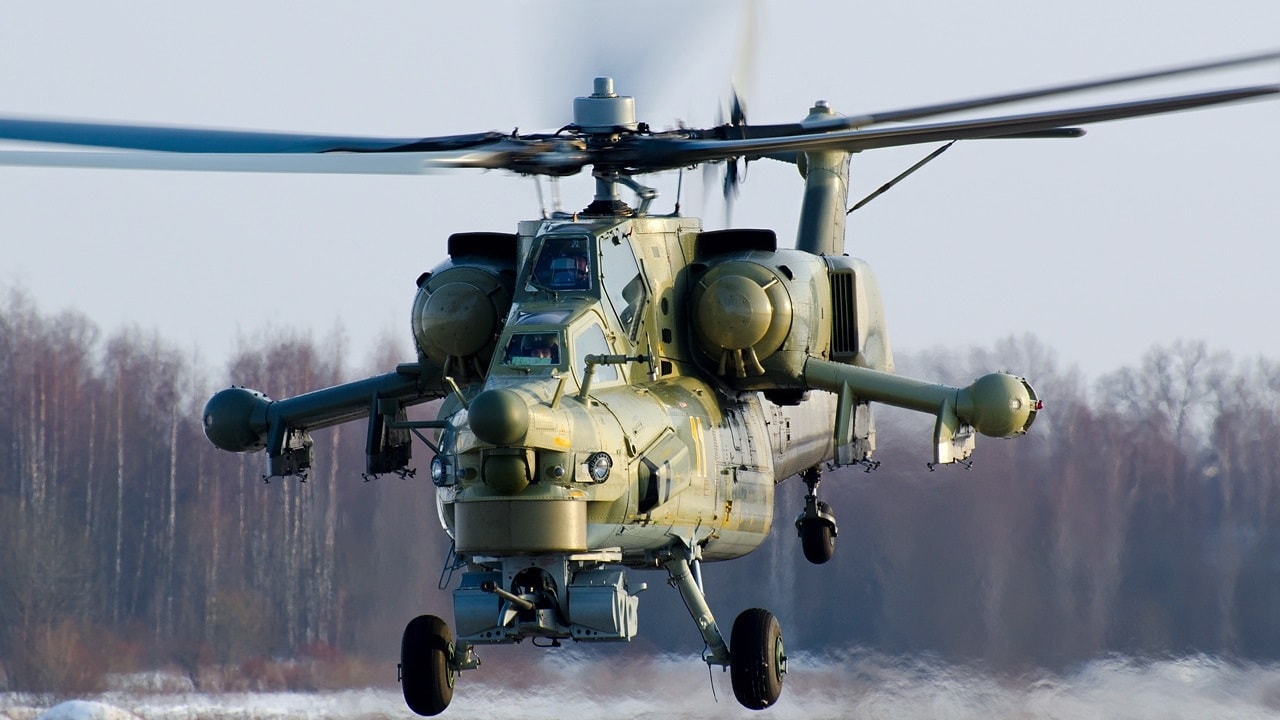The Mil Mi-28 took the long road from design to active duty. Despite work on the Mi-28 concept beginning in 1980, the finished product did not enter service with the Russian armed forces until 2006 – nearly three decades later. The two-seat anti-armor attack helicopter seems to have been worth the wait – 112 units are in service, with 105 on order.
During the three decades in which the Russians were tinkering with the Mi-28, they cycled through multiple design variants; the helicopter in service today is the culmination of endless trial and error. In the final design, two Isotov TV-3 117VM turboshaft engines sit atop the fuselage, powering the Mi-28. The two engines enable a max speed of 200 miles per hour, with a cruising speed of 170. The Mi-8 enjoys a 435-mile range and a service ceiling of 18,700 feet. The gunship can climb at 2,680 feet per minute.
The two-seater features “stepped-up” cockpits, each encased within full armor, including bulletproof windshields capable of withstanding 7.62 and 12.7 armor-piercing bullets. The Mi-28 has another clever safety feature: energy-absorbing landing gear and energy-absorbing pilot seats – each of which enables the crew to survive a 12-meter-per-second vertical fall.
While the Mi-28 is capable of carrying three extra troops (for rescuing downed helicopter crews), the helicopter was designed singularly for attack purposes. The Mi-28’s predecessor, the Mi-24, was designed as an attack helicopter that also had low-capacity transport abilities. Predictably, sacrifices were made to the Mi-24’s attacking ability, in order to incorporate the ability to transport troops. The end result is something of a Frankenstein between an attack helicopter and a transport helicopter – capable of both tasks but failing to excel in either. So, instead of compromising attack capacity for the sake of transportation, the Mi-28 was designed especially for attack functions. Accordingly, the Mi-28 is well-armed.
Carrying a “chin-mounted” NPPU-28 turret with a 30 mm automatic Shipunav 2A42 autocannon, the Mi-28 can fire between 200 and 800 rounds per minute. The Mi-28 carries missiles, too; the Mi-28 can be outfitted with the supersonic 9M120 Ataka-V missiles. Multiple variants of the Ataka are available, each designed for a specific task. For example, the High Explosive Anti-Tank (HEAT) variant is used against tanks equipped with Explosive Reactive Armor (ERA). The thermobaric Ataka variant is best against infantry and fortifications. And the expanding rod variant is used against fellow helicopters. The Ataka missiles all rely on the SACLOS missile guidance system, making them a sophisticated, accurate weapon. The Mi-28 can also carry unguided rockets, under the stub wings. Upwards of 50 rockets are carried, from rocket pods.
The Mi-28 made its combat debut in 2016, at the Battle of Palmyra in the Syrian civil war, when Russian Mi-28s fought on behalf of the Syrian Arab Army, targeting ISIS forces. And of course, the Mi-28 is being used currently, in the Russo-Ukraine War. Allegedly, the Ukrainians shot down one Mi-28 in April, using a British-made MANPAD Starstreak system.
Recommended: Why China’s Economy Could Collapse
Recommended: Why No F-35 in Top Gun: Maverick?
Recommended: Why Using the F-35 in Top Gun: Maverick Made Sense
Russia is marketing their new attack helicopter for the export market. Already, the Russians have sold the Mi-28 to Iraq – roughly two dozen units for $4.2 billion. Algeria has a batch. And Bangladesh appears to be in the final stages of closing a deal for the Mi-28, too. India, worried about Chinese adventurism, asked Russia for a modified prototype of the Mi-28. Kenya and Venezuela have also been exploring the possibility of purchasing the Mi-28.
Harrison Kass is a Senior Defense Editor at 19FortyFive. An attorney, pilot, guitarist, and minor pro hockey player, he joined the US Air Force as a Pilot Trainee but was medically discharged. Harrison has degrees from Lake Forest College, the University of Oregon, and New York University. He lives in Oregon and regularly listens to Dokken.

